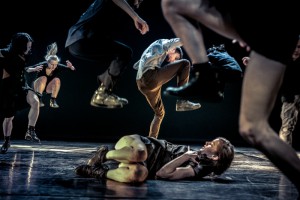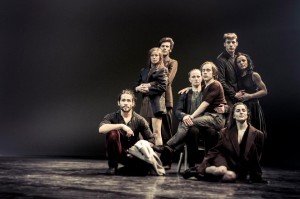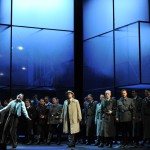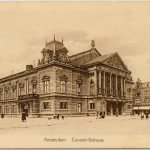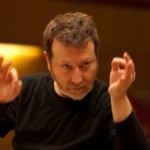by Sedgwick Clark
I first met Omus Hirshbein in Carnegie Hall’s executive offices, where he worked for a brief time in 1973 between tenures at the Hunter College Concert Bureau and the 92nd Street Y. He was walking out of a planning meeting, saying in frustration to anyone nearby, “They won’t listen to me—they should be emphasizing the sound of Carnegie Hall.” Guess what Carnegie’s subscription campaign was the next season, after Omus left for the Y? There he would create a concert series that for two decades would dominate the chamber-music field in New York (and annoy the hell out of me because it was such a nuisance to get to from my apartment near Lincoln Center).
We became friends over the years, especially after buying one of his pianos several years ago when his upper West Side apartment could no longer house two Steinways. Every time my wife and her four-hands partner, the composer and conductor Victoria Bond, get together to play, we think of Omus and his wife, Jessica.
Omus died on December 31st after a long decline due to Alzheimer’s. It seems especially tragic that one whose mind was so fertile would leave us in such a manner. I’m sorry I took so long to take note of him in this forum. Perhaps I was stymied because Brian Kellow, who worked for Omus at the Y in the 1980s, captured his personality and accomplishments so warmly and vividly in an Opera News piece, as did Allan Kozinn in his New York Times obituary (January 7, 2012). So I decided I would do something different and reprint Omus’s own typically impassioned words from a panel discussion on the programming of classical music, which appeared in the 1995 Musical America Directory. Participants with Omus in the discussion were industry V.I.P.s Deborah Borda, Eugene Carr, Mary Lou Falcone, Christopher Hunt, and Jane Moss. I highly recommend your reading it; check out the Services section on top of the Musicalamerica.com desktop. You may find, as I did when I read it again, that it could have been recorded yesterday.
Omus Hirshbein: “I think there are two reasons why people like to go to concerts these days. One is being addressed by the kind of programming that the American Symphony is doing. Back in 1986 I agreed to put together a series of eight concerts for the Museum of Modern Art exhibition called “Vienna 1900.” It had to do with the years of the Vienna Secession, which are roughly 1898-1918, and the composers were Schoenberg, Berg, Webern, Zemlinsky, Schmidt. And I said to them, “But no one will come.” To my surprise, tickets were being scalped on 53rd Street. I saw virtually none of the usual New York music people at those eight concerts. Audience members were reading, they were seeing the paintings, they were seeing the workshop of Hoffman, and they were hearing a group of composers described by curator Kirk Varnedoe as part and parcel of the Secession, and they went. Okay, that’s one reason.
“The other, of course, is that music is supposed to touch the heart. And it’s supposed to touch the soul. Now, there was a period of 40 or 50 years when what was new was ugly. Sorry, it was mostly ugly. And the legatees of those Viennese geniuses—and I speak of Schoenberg as a genius—made it worse. They became academic, producing a system of writing in this country that was not for the public. Now, there are some young people writing music today who are mobbed by audiences. I’m talking about Aaron Kernis, and Bright Sheng, and there are others. And maybe it signals a reversal of that horrible trend where what was new was impossible to listen to. That’s all I can hope for, because the teaching of music has become of little importance in most of the major cities today as they cope with their social and educational problems.
“Let me just add that money is really an issue. And I’m not talking about balancing budgets. On the wall in my new office is a blowup of an advertisement from 1971, announcing a repeat concert of Victoria de los Angeles and Alicia de Larrocha doing a program of Spanish tonadillas and whatnot. I ask people to look at it because it has tremendous meaning—and finally down at the bottom, they come across what is really disturbing about it. And this is 1971, folks. The top price at the Hunter College Concert Bureau, where this took place, in a 2,200-seat house, was a dollar below Carnegie Hall and a dollar below Lincoln Center: six and a half dollars. A movie was three bucks, or three and a half. A musical event of that magnitude was twice the price of a movie. And that was prevailing.
“Now, I throw down a gauntlet to the commercial interests that have ruined our business. I assure you that Mostly Mozart once was a three- and four-dollar ticket. Commercial interests, and the interests of unions, have hurt us a great deal. This not a high-tech business, this is not the movies, this is not mass media, and we are paying the kind of monies out that would say it’s mass media, and it ain’t anything like that.
“. . . I had a staff of music lovers in my previous job. Music lovers. A couple of them were married, they were in their thirties, and you know what they do? They get together with their friends in a restaurant, and they spend an evening, and that’s all they can afford to do; they are making $23,000 and $24,000 a year, and they cannot afford to go to these concerts.
“. . . There’s another side of the coin. Once the performer becomes recognizable, there is the most extraordinary avarice to get the fees up as fast as possible. And that, for me, is what has wrecked the business. An artist could go on the road and make a decent living at fees somewhere in the $5,000 or $6,000 range and that’s about all that anybody out there in the hinterlands can afford. Now, I think maybe that’s all I have to say.”
Of course, it wasn’t all he had to say. His last professional endeavor was to found, with his former Y colleague Jacqueline Taylor, a series of free public concerts with major artists that they called “Free for All at Town Hall.” They wrote about its genesis in the 2004 edition of Musical America Directory, and we can still look forward to these concerts each spring. Martin Riskin, who is now president and artistic director of the series, tells me that the upcoming concerts will be dedicated to Omus.
Looking Forward
My week’s scheduled concerts:
2/1 Paul Hall. FOCUS! Festival. Cage: Five Songs (1938); Six Melodies for Violin and Keyboard (1950); Imaginary Landscape No. 1 (1939); Etudes Boreales, Nos. 1 & 3 (1978); Sonnekus² (1985); Satie Cabaret Songs; Child of Tree (1975); The Perilous Night (1944).
2/7 Rodgers Theatre. Gershwin: Porgy and Bess. Audra McDonald (Bess), Norm Lewis (Porgy), David Alan Grier (Sportin’ Life).
1/8 Peter Jay Sharp Theater. Gluck: Armide. Juilliard Orchestra/Jane Glover. Emalie Savoy (Armide), Alexander Hajek (Hidraot), David Portillo (Renaud), Alexander Lewis (Artémidore), Luthando Qave (Ubalde), Noah Baetge (Le Chevalier Danois), Wallis Giunta (Phénice), Devon Guthrie (Sidonie), Evan Hughes (Aronte), Renée Tatum (La Haine), Soo Yeon Kim (La Naïade), Pureum Jo (2nd Coryphée), Deanna Breiwick (Une Bergère), Lilla Heinrich-Szász (Lucinde), and Raquel González (Mélisse).


